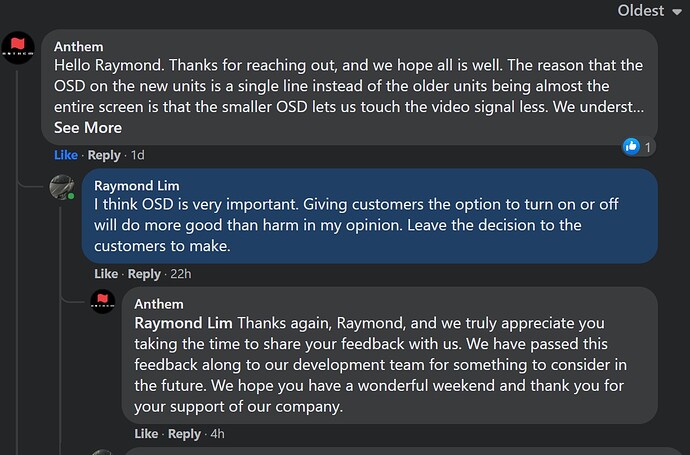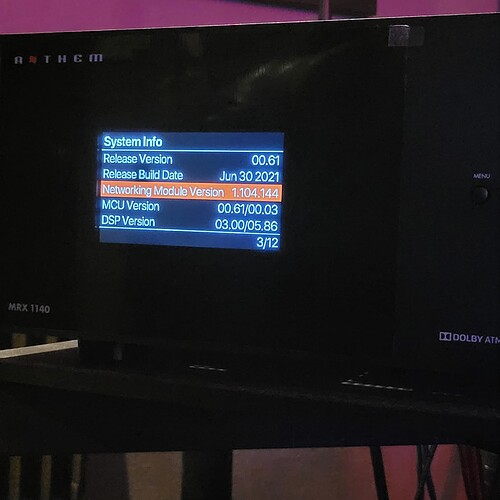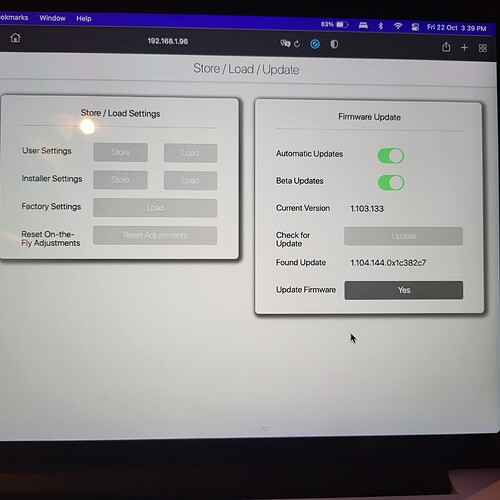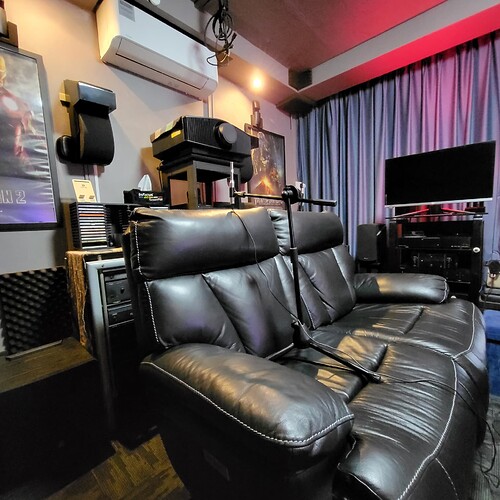The chip shortage is really making a dent in many AV products. But well at least Anthem acknowledged their shortcoming…I’ll accept that. Let’s hope this feature will be made available soon.
Yes it hit hard. The usual 4 to 8 weeks became 4 to 6 months. I still owe customer power amp and it’s already 4 coming 5 months…
Bring back the OSD
Kind of BS when Anthem says “smaller OSD” (2 lines of text to be precise) will have “less impact” on the video signal? If really wanna go purist, shouldn’t even have any OSD to begin with. Look on the bright side, at least they will forward my request to the team and hope it can be implemented soon but I’m not holding my breath.
Objective testing by ASR on the new Anthem AVM70.
Great to see that the measurements are good.
any news abut the the phase correction?
Unfortunately no. Not sure what’s taking Anthem so long to implement this feature when it is already available in its STR integrated Amp series.
Happy to announce that I’ll be joining the Anthem family in abt 30 days…
Just placed order for the AVM70 
Yup… Just read your post in the other thread. Just one month waiting time? Wow… That’s good to know. You order directly from TEG or E77? Hope you placed a deposit to secure the stock when it becomes available.
I’ll be updating some setup process on ARC calibration which will be very useful for users doing with ARC calibration.
Yep, I reached out to E77 and they have a spare unit incoming in 30days.
So i paid the deposit to secure the unit - looking fwd to playing with it;
I was considering AVM90 in case I needed 4 subs;
Desray,
I understand u hv 3 subs, do u split the signal from one of the channel?
Bro, personally I think there is no need to go for AVM 90 even if you intend to go for 4 subwoofers in the future. Granted, 4 independent subwoofer calibrations sounded like a subwoofer nirvana but then again, Anthem has yet to deliver what it promise - i.e. Auto phase control to properly time align the subwoofers at this point. They did promise to users that they will eventually deliver and we are holding their words for it… Unfortunately they did not specify a time line and I’m quite pissed at that. Of course there are other ways to align the subwoofers using REW and miniDSP 2x4HD but you no need to rush out to get it if Anthem eventually going to release that feature.
And yes, I’m using 3 JL Audio subwoofers at the moment. What I did is to use the Y adaptor to output the LFE signals to 2 subwoofers in front and another sub Pre-Out to my 3rd subwoofer located at the rear of my MLP. Because of arrangement, phase control of the 3 subwoofers and delay (time align) are important. Without the miniDSP, I’ll have to play with phase for each of the subwoofers and then measure with REW to get an even response when the 3 subwoofers readings are combined as one.
Unfortunately I think and suspect they will not release this feature.
This was the main reason why I purchased the MRX-1140.
This feature already exists in the STR series and I can not understand why the phase correction has not yet been released.
They do not respond to emails and give technical answers when needed.
I personally lost faith in the company but I hope I will be cheated and finally the update comes out.
In the marketing blurb, it mentioned independent subwoofer channels…meaning it can recognize 2 individual subwoofers at “different” placement. We know that Anthem MRX or AVM does not provide distance calculation and requires users to input the distance ourselves. Auto-phase control is very important to get this right, if not, an independent subwoofer calibration is pretty useless. If Anthem is screwing with the customers on this…then they will have to answer to many irate customers (me included) who bought the MRX 740/1140 (and not MRX 540) or even the AVM 70/90 simply because of this independent subwoofer calibration feature.
Anthem’s product usually has a 5-years life cycle…so throughout this 5 years, Anthem can release it anytime…let’s cling on to the hope that it will be released sooner rather than later. Besides, Anthem have already committed in several FB posts to their customers (in writing) that they will release it sometime in the future.
In the receiver line the 1140 is only unit that offers independent sub calibration.
That’s right.
Review of AVM 70 by AVForums - this is for bro ricky101
A small update for a more stable network connectivity via Wi-Fi connection. No change log from Anthem on this update.
TIPS ON ARC CALIBRATION
I have revised some of the techniques when calibrating with ARC to achieve optimum results. Take this as the much-needed TL;DR post to help newcomers get started with ARC.
Quick Measure
Even before you start the ARC calibration process, you will need to do a “quick measurement” to get 2 important things set up correctly first. There are:
- Find and set the correct reference level
- Tune the gain of the subwoofer to reach 75dB (for single subwoofer) or 71dB for dual subwoofers
The current beta version of the ARC sets the master volume at -37.5dB which is way too low (a difference of about 5 - 6dB difference) to reach “75dB” (Reference level). As such, you will probably end up with a positive integer of +4.5dB instead of the usual negative integer that most of us are familiar with after calibration. I’m not sure why Anthem did not notice this bug but I hope when the official version of the ARC software is released, this bug will be fixed.
Depending on the sensitivity of your speakers, YMMV. For instance, my KEF R100 mains register about -31.5db (an increase of about 6dB from -37.5dB). Let me repeat again, this is not an arbitrary figure that you can simply plug in. What you need to do is to use the Quick Measure tool found in the ARC calibration software (ver 1.5.4 Beta) and do a quick measure to get the correct reference level - i.e. 75dB. You will need to fire up your browser and go into the WebUI and make adjustments to the Master Volume until you hit 75dB. Note down the Master Volume level as it will come in handy next time when you need to re-calibrate your system. Once you’ve set the correct Master Volume, take a look at the Receiver/AVM VFD and you should see the Master Volume change.
Subwoofer Phase Control
Next, you will do a quick measure of the subwoofer readings to attain 75dB (for a single subwoofer) or 71dB (for dual subwoofers). Take this opportunity to play with the phase control to achieve a flat response curve as much as possible. Remember ARC, like most room EQ will not correct the dip too much (max of about 6dB correction), so if you are still unable to get a generally good flat response at a location, try to either move the subwoofer(s) a few inches or a foot to the left, right, front or rear as it will change the response curve. Alternatively, you can also move your seating position (MLP) to either front or back a foot or two. It will make a difference, trust me.
ARC Calibration
Recall the new Master Volume setting which you have acquired during the Quick Measuring phase. Now go to the WebUI again and make sure to input the correct level - in my case, it is -31.5dB (YMMV).
Perform a minimum of 5 position calibrations with variation in placement (about a foot from the previous position and height of the mic). Perform a “X” formation mic readling layout. It is known to yield more accurate results.
Check Post ARC Results
After completion, go to the “Adjust Settings” tab and check the Speaker level for your speakers and subwoofers are within an acceptable range of between “-3.0dB and +3.0dB” thereabouts. If you have set your reference level (75dB) correctly before the start of the ARC calibration, your speaker and subwoofer level should have a negative integer or sometimes “spot-on” at “0db”. If the numbers are out, re-do ARC.
Room Gain and Deep Bass Boost
Go to the System Level Wide setting and set the Room Gain to about +3dB (baseline) and Deep Boost Bass level to around +2dB to give you that “chest slamming” bass. The Room Gain will have its frequency center set at around 200Hz, you can experiment by lowering it further to 150Hz if you want, The Room Gain setting is akin to the proverbial “house curve” which sports a gradual ascend of the frequency curve from 200Hz to 20Hz. This is something that Audyssey can take a leaf from Anthem in designing a house curve after Audyssey calibration. Of course, Audyssey Editor App is used to fill this void but it is an additional cost that a user has to pay.
Limit the correction filter to 500Hz
Next, adjust the correction filter from the default 5KHz down to 500Hz (but not below 200Hz) for all the speakers.
After you have checked and set the abovementioned settings, upload the ARC results to the Receiver or AV Amp. Play a few familiar music tracks and movies with nice amount of Dolby Atmos effects and bass. If you like what you hear, save the ARC calibration results (.arc) and refine further as you see fit.
Creating different Profiles
You can create 2 or more profiles for different sources. Example, you can create a profile with 7.2.4 for movies or you can even create another profile that omit the centre speaker (6.2.4) to try out “phantom centre” channel for those who does not have a dedicated centre channel or even a 2.2 layout for front mains and subwoofer(s) for 2 channel playback. There are many variations to try but always remember to preserve the base layer (original .arc file) in case you screw up along the way.
If you have any questions, post it here and I’ll try my best to answer…





